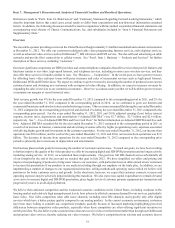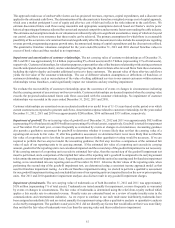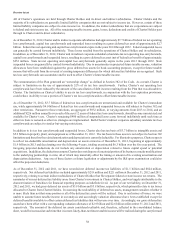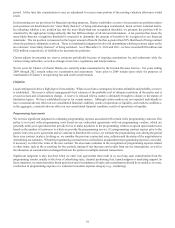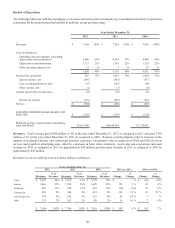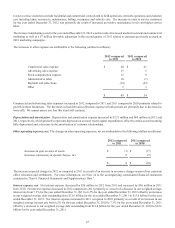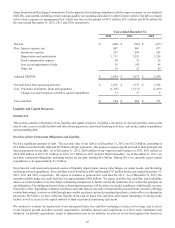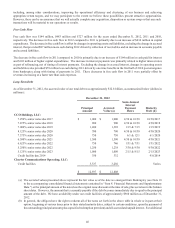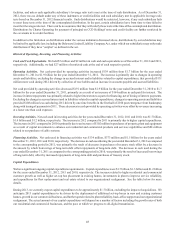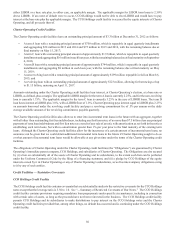Charter 2012 Annual Report Download - page 54
Download and view the complete annual report
Please find page 54 of the 2012 Charter annual report below. You can navigate through the pages in the report by either clicking on the pages listed below, or by using the keyword search tool below to find specific information within the annual report.
42
Commercial revenues consist primarily of revenues from services provided to our commercial customers. Commercial PSUs
increased 55,000 and 36,000 in 2012 and 2011, respectively. The increases in commercial revenues are attributable to the following
(dollars in millions):
2012 compared
to 2011 2011 compared
to 2010
Sales to small-to-medium sized business customers $ 87 $ 71
Carrier site customers 17 18
Other 9 9
Asset sales and acquisitions 1 (5)
$ 114 $ 93
Advertising sales revenues consist primarily of revenues from commercial advertising customers, programmers and other vendors.
Advertising sales revenues increased in 2012 primarily as a result of an increase in revenue from the political and automotive
sectors of $20 million and $12 million, respectively. In 2011, advertising sales revenues increased as a result of an increase in
revenue from the automotive sector of $3 million combined with an $8 million change to account for revenues received from
selling advertising for third parties on a gross basis rather than a net basis, offset by a decrease in revenue from the political sector
of $10 million. Asset sales and acquisitions reduced the increase in advertising sales revenue by approximately $1 million in 2011.
For the years ended December 31, 2012, 2011 and 2010, we received $59 million, $51 million and $46 million, respectively, in
advertising sales revenues from vendors.
Other revenues consist of home shopping, late payment fees, wire maintenance fees and other miscellaneous revenues. The
increase in 2012 was primarily the result of increases in late payment fees. The increase in 2011 was primarily the result of
increases in late payment fees and wire maintenance fees. Asset sales and acquisitions reduced the increase in other revenues in
2011 by approximately $1 million.
Operating costs and expenses. The increases in our operating costs and expenses are attributable to the following (dollars in
millions):
2012 compared
to 2011 2011 compared
to 2010
Programming $ 100 $ 73
Franchise, regulatory and connectivity 8 (5)
Costs to service customers 90 17
Marketing 34 (5)
Other 49 34
Asset sales and acquisitions 15 (36)
$ 296 $ 78
Programming costs were approximately $2.0 billion, $1.9 billion and $1.8 billion, representing 41% of operating costs and expenses
for each of the years ended December 31, 2012, 2011 and 2010, respectively. Programming costs consist primarily of costs paid
to programmers for basic, premium, digital, OnDemand, and pay-per-view programming. The increases in programming costs
are primarily a result of annual contractual rate adjustments, including increases in amounts paid for retransmission consents and
for new programming, offset in part by asset sales and customer losses. Programming costs were also offset by the amortization
of payments received from programmers of $6 million, $7 million and $17 million in 2012, 2011 and 2010, respectively. We
expect programming expenses to continue to increase due to a variety of factors, including increased demands by owners of some
broadcast stations for carriage of other services or payments to those broadcasters for retransmission consent, annual increases
imposed by programmers with additional selling power as a result of media consolidation, and additional programming, including
new sports services and non-linear programming for on-line and OnDemand programming. We have been unable to fully pass
these increases on to our customers nor do we expect to be able to do so in the future without a potential loss of customers.



